by tmoffett | May 17, 2012 | Color, Composition, Photographic Philosophy
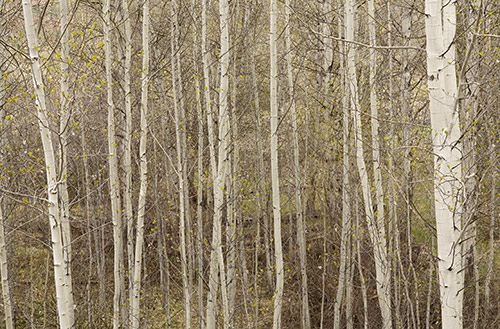
Aspens, Sun Valley, Idaho
Part of my job as a photographer is to simplify the chaotic world that we live in so that the images created in my camera are easy and interesting to look at. Most of the time, the scenes that present themselves to us are filled with so much “stuff” that it is hard to isolate individual elements. If we don’t train ourselves to look for simplicity, we will rarely find it. I often tell my students that I see the world better than they do because I see differently. I have looked so long for small elements that interest me that that is now what I see. My photographs are my vision. That is how I see the everyday world.
Composition is critical to creating interesting images. Painters, I think, have the advantage here because they start with a blank canvas and add only those elements that are needed for the image. Photographers, on the other hand, must find those compositions in nature, and then capture them in the camera. One afternoon as I was walking along the river in Sun Valley, I happened upon this aspen grove. When you look into the photograph, there is a lot going on, however as I looked and thought about what it was that made me stop, I realized that the repeated vertical lines of the tree trunks are what interested me. The muted color and tones created by a late afternoon overcast sky enhanced a feeling of peace and calm. Given the time, I could sit in the middle of this grove in meditation for hours and not feel bored. The strong vertical lines of the trees give my eyes a pattern to follow and places to rest after wandering throughout the other areas of the photograph.
I love finding images that seem to create order out of chaos. My vision is a very simple vision, and in the fast paced society in which we live, visualizing the simple things slow life down for me and helps me to live a more relaxed life.
by tmoffett | May 15, 2012 | Color, Composition, Landscape, Photographic Philosophy
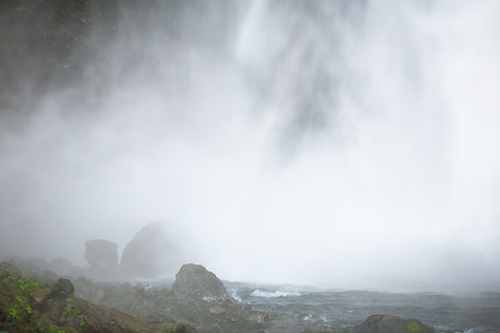
Impact Zone, Multnomah Falls
When traveling to the Northern Oregon Coast I will frequently stop at Multnomah Falls, a very popular and spectacular waterfall that is right next to the highway. I find it interesting that even though I have stopped and photographed this waterfall on numerous occasions, I have never printed an image of the entire falls. I am, for some reason, drawn to the details of this amazing display of water power. This past trip through the Columbia River Gorge was no different. I hiked up to the bridge that provides a great view of impact zone, the area where the falling water meets the pool below. It was fascinating to me. I stood watching as the spray of cold water soaked me and my gear to the bone. I realized what it was I needed to photograph. The trouble was figuring out how to keep my lens dry enough to get the image.
I set up my camera on the tripod and, not worrying at first about getting wet, framed up the image. I needed to capture the falling water at the edge of the frame with the spray and mist blowing through the frame to the left side, causing a thick haze across the entire frame. After framing it up and calculating the needed exposure to show the texture of the falling water in the background and create the desired haze in the foreground, I dried the lens and, with the help of my wife, kept the lens covered until just prior to tripping the shutter, then immediately after the exposure, covered the lens again. About every third shot, I stopped to dry off the lens again. It was quite a challenging process, however very rewarding as well.
Masterpieces are very rarely created in an easy setting. I believe that it is the challenges that allow us to create great images. In photography, just as it is in life, anything worth doing is worth working for. In conditions where everyone else packs it in and goes home, he who perseveres is bound to create something great. It is that challenge that I am constantly striving for. That is one reason that when I saw the forecast for heavy rain I opted to go to the coast. I knew that the adverse conditions would force me to look at things a little differently than I had in the past. I would attack the situation head on and was confident that I could win. I certainly was glad that I did as I returned home with a few great images added to my portfolio.
by tmoffett | Apr 24, 2012 | Color, Composition, Landscape
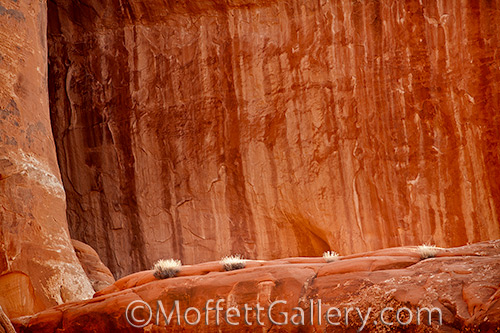
First Light, Arches National Park
One of the hardest principles of good composition to teach is that of simplicity. Elimination of everything in the frame that does not enhance the image creates a composition that will have much more power and impact on the viewer. Slowing down is the key. In today’s world, we are so used to multi-tasking that slowing down and simplifying anything is against our nature, yet doing so, I have found, allows me to enjoy life so much more. I see differently when I take the time. My vision becomes more clear. My photographs become more powerful.
This is an image that I made while at Arches National Park recently. I had hiked in to Landscape Arch in the dark in order to be there for sunrise. As the sky grew lighter, I turned around and this is what I saw. It was not what I had come for, but was a pleasant surprise. These four plants, catching the first rays of morning light as they grew out of solid rock were a better composition and much more powerful and meaningful than the arch I had come to photograph. So many times I have hit my own “Brick Wall” and wanted to give up, but persevering, stretching and growing, I was able to overcome and move forward, much like these plants in this sandstone environment. There are many images in nature that when simplified, can relate to our own lives. Parallel meanings are often hid behind confusion, that when we slow down, become observant and eliminate the excess, we will find. When we do, our art becomes powerful.
by tmoffett | Apr 19, 2012 | Color, Composition, Critique, Landscape, Photographic Philosophy
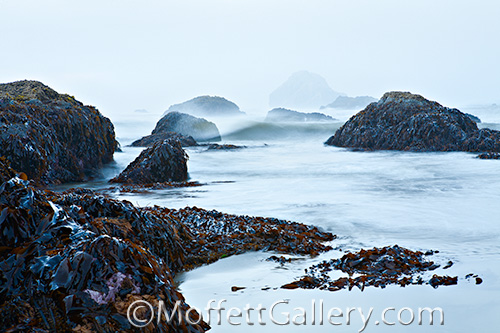
Shoreline at Bandon, Oregon
This happens to be one of my favorite images that I have made along the Oregon Coast. It was a cool, breezy morning and the marine layer was thick, which meant that I would have no dramatic sky. On the coast that is not unusual. I really like what happens here, though. The fog allows for the ocean to appear to vanish into the sky, creating a vastness that otherwise may not be apparent. The thick fog and bluish color of the image helps in creating a coolness, resembling my feelings as I photographed. My images are always about my feelings. It may be what I see, but even more about how I see and what I feel. This particular morning I was cold and wet as I walked the beach in search of an image. I knew, as I walked around the rocks to this location, that I had found what I was looking for. I must have spent 30 minutes or more just watching and dodging the waves as they rushed ashore, finding the correct angle for the composition that said what I wanted and timing the exposure to capture the motion of the water, creating an image resembling the feelings inside of me. When everything comes together as it did here, I am amazed at what can happen.
Photography is really not about the final image, it is about the experience, living the experience and then sharing it through the photographs created.
by tmoffett | Apr 5, 2012 | Color, Composition, Landscape, Photographic Philosophy, Portraits, Ramblings
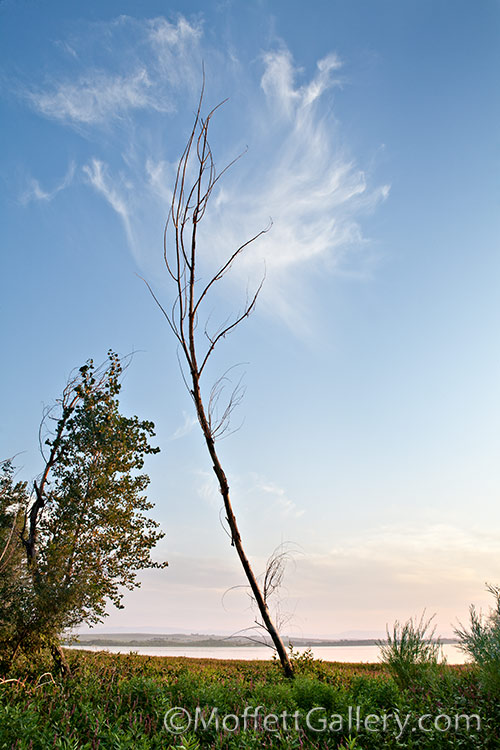
Reaching Upward
While out photographing one evening with a small group of students this image presented itself to me. The students all were hurrying out to the shore of the lake while I took my time observing and enjoying the environment. It was a great teaching moment the next day as I showed the image that everyone had passed up in an effort to get to the final destination. This was my favorite image of the evening. I hope that my students learned something from the experience.
I have learned much from other photographers. Some I have met, others just learned from their photographs. Here a few of my favorite photographers, but by no means is this an all inclusive list. I could list a hundred others who have in some way or another influenced me and my work.
1. Paul Caponigro He will always be on the top of my list. Paul Caponigro is my all time favorite. His images of Stonehenge and other megaliths are very moving. He has a way of really showing emotion in his photographs. I never tire of his photographs.
2. Henri Cartier-Bresson Famed for coining the phrase “The decisive moment.” His simple journalistic style and masterful composition make his images one of a kind. Finding a location and waiting patiently for the right moment to appear in is lens is something that we can all learn from.
3. Yousef Karsh My favorite portrait photographer of all time is Karsh. He had a way of capturing the soul of his subject. This, I believe, can only truly be accomplished by spending time with the subject, which he did. Learning who your subject is and then carefully crafting the portrait with perfect lighting and natural posing are a few of the things that Karsh’s portraits have inspired me to do. A Karsh portrait really communicates.
4. Arnold Newman Another portrait artist whose work has had a great influence on me. He was a master of the environmental portrait with a very simple style.
5. James Nachtwey The importance of being trusted by your subject is evident in his work. His photographs speak for his subjects and can make a difference in the world. Nachtwey brings a very intimate approach to war photography that makes him an advocate for peace.
6. Jay Maisel It’s all about light, shape and color. Find photographs in your everyday world and surroundings. They are there, we just need to find them. That is what Jay Maisel has taught me.
7. Irving Penn I really like his still life images. Simple, yet powerful composition and masterful lighting skills make his photographs some of my favorites.
8. John Sexton His black and white landscape photographs are inspiring. Learning to photograph in the quiet light at the end of the day after the sun has set is something I have learned from the images of John Sexton. Many of his images have a very peaceful, simple look that is very fresh. He is another whose images I never tire of.
My list could go on and on. Everyone has a favorite that could be added, but these are a few of mine. As I look at the work of these eight photographers, the common thread I see that draws me to their work is simplicity. They all have a way of making simple, powerful images. That is something that I have been trying to master for as long as I can remember. The simpler a photograph, the more power that it has. In our complex world, simple is also very refreshing. It is easy to look at. It is peaceful. It communicates. I have learned that by studying the work of other artists and photographers my own work improves. I only wish that I had more time to devote to looking at photographs.
by tmoffett | Apr 3, 2012 | Color, Composition, Landscape, Photographic Technique
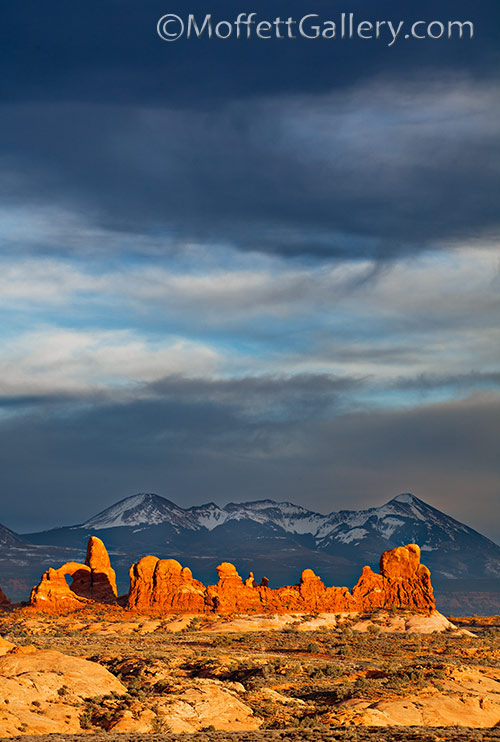
Arches National Park, Moab, Utah
As a landscape photographer I chase light. I have found that when the light quality is great, the resulting photograph will be great. The contrary is also true. If light quality suffers, so will the photograph, even if the location and composition are great. Add great composition to great light and it gets even better, then add emotion and the image becomes spectacular.
All last week I spent in the Moab, Utah area. Arches National Park, Canyonlands and Dead Horse Point all offer interesting subject matter for photographers. The difference maker for good or great photographs becomes light quality. All week long the light quality was good at best, not great. Then the last evening I was there, everything set up quite nicely. Dark clouds began to move in to the east. Heavy clouds were in the west interfering with the light, but there was a small band of clear sky between the horizon and the cloud cover. I watched and waited, knowing that just before sunset, the sun would break out and bathe the rock formations to the east with warm light. I was not disappointed, it happened just as expected. Photographers all over the park were treated to a scene that does not frequently occur. I was in in awe. It lasted only a few minutes and was gone. That few minutes is what being a photographer is all about.








Recent Comments